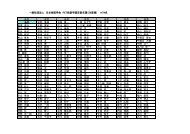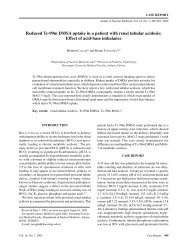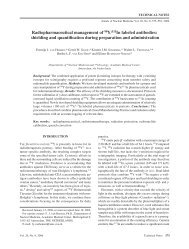Distinguishing benign from malignant gallbladder wall thickening ...
Distinguishing benign from malignant gallbladder wall thickening ...
Distinguishing benign from malignant gallbladder wall thickening ...
Create successful ePaper yourself
Turn your PDF publications into a flip-book with our unique Google optimized e-Paper software.
<strong>thickening</strong> observed in 7 cases). 10 Anderson et al. evaluated<br />
the usefulness of PET in cases of <strong>gallbladder</strong> carcinoma<br />
and cholangiocarcinoma, as well as in 14 cases of<br />
<strong>gallbladder</strong> disease, and reported that the sensitivity of<br />
PET in detecting <strong>gallbladder</strong> cancer was 78%. 11 Koh et al.<br />
performed PET on 16 patients with protuberant lesions of<br />
the <strong>gallbladder</strong>, and reported that PET was superior to CT<br />
in diagnosing <strong>gallbladder</strong> cancer, with a sensitivity of<br />
75% and specificity of 87.5%. 12<br />
Gallbladder cancer can be divided into two types, that<br />
presenting as an protuberant lesion and that characterized<br />
by <strong>gallbladder</strong> <strong>wall</strong> <strong>thickening</strong>. It has been thought that a<br />
protuberant lesion in the <strong>gallbladder</strong> over 15 mm in size<br />
is very likely to be <strong>malignant</strong>. 22 The protuberant type can<br />
be distinguished between <strong>benign</strong> and <strong>malignant</strong> tumors<br />
with the conventional imaging techniques, CT, MRI, US,<br />
and so on. The latter type of <strong>gallbladder</strong> cancer is more<br />
difficult to distinguish preoperatively <strong>from</strong> <strong>benign</strong> <strong>gallbladder</strong><br />
disease, since <strong>wall</strong> <strong>thickening</strong> is also noted in<br />
cases of cholecystitis, adenomyomatosis, and other conditions.<br />
In the present study, we performed PET on patients<br />
found only by CT or US to have <strong>gallbladder</strong> <strong>wall</strong> <strong>thickening</strong>.<br />
When used to distinguish between <strong>malignant</strong> and<br />
<strong>benign</strong> <strong>gallbladder</strong> <strong>wall</strong> <strong>thickening</strong>, PET had a sensitivity<br />
of 75% and specificity of 100%. There was one case (Case<br />
4) in which the results of PET examination were falsepositive.<br />
Acute/chronic cholecystitis and xanthogranulomatous<br />
cholecystitis are reported to be sometimes falsepositive<br />
in the <strong>gallbladder</strong> <strong>wall</strong> <strong>thickening</strong> type, 12,14,16,17<br />
because FDG is taken up by activated inflammatory cells.<br />
Nishiyama et al. stated that false-positive findings are<br />
likely in cases in which CRP > 1, that CRP is a good<br />
predictor of the specificity of PET, and that not only CRP<br />
but also other clinical or laboratory data emphasizing the<br />
exsistence of acute inflammatory conditions might be<br />
helpful. 16 In our study the false-positive case had developed<br />
acute cholecystitis one year previously. At the time<br />
of PET, this patient had neither clinical symptoms nor<br />
hematological findings of acute inflammation, with a<br />
CRP of 0.2. But the postoperative pathologic examination<br />
revealed intense inflammation and adhesion of the <strong>gallbladder</strong><br />
<strong>wall</strong> to the liver, where there was abnormal FDG<br />
accumulation. FDG was thought to be taken up because<br />
there were severe inflammatory lesions at the cell level<br />
even though CRP was negative.<br />
The results of the present study indicate that preoperative<br />
distinction between <strong>benign</strong> and <strong>malignant</strong> <strong>gallbladder</strong><br />
<strong>wall</strong> <strong>thickening</strong> is possible with PET. If PET is used<br />
for this purpose, it may be possible to avoid unnecessary<br />
surgery. Because the number of cases evaluated in this<br />
study was very small, and because very few reports have<br />
been published on this topic, further evaluation is needed<br />
in a larger number of cases.<br />
702 Ai Oe, Joji Kawabe, Kenji Torii, et al<br />
REFERENCES<br />
1. Van den Abbeele AD, Badawi RD. Use of positron emission<br />
tomography in oncology and its potential role to assess<br />
response to imatinib mesylate therapy in gastrointestinal<br />
stromal tumors (GISTs). Eur J Cancer 2002; 38 (Suppl 5):<br />
S60–65.<br />
2. Kitagawa Y, Nishizawa S, Sano K, Ogasawara T, Nakamura<br />
M, Sadato N, et al. Prospective comparison of 18 F-FDG<br />
PET with conventional imaging modalities (MRI, CT, and<br />
67 Ga scintigraphy) in assessment of combined intraarterial<br />
chemotherapy and radiotherapy for head and neck carcinoma.<br />
J Nucl Med 2003; 44: 198–206.<br />
3. Hoh CK, Hawkins RA, Glaspy JA, Dahlbom M, Tse NY,<br />
Hoffman EJ, et al. Cancer detection with whole-body PET<br />
using 2-[ 18 F]fluoro-2-deoxy-D-glucose. J Comput Assist<br />
Tomogr 1993; 17: 582–589.<br />
4. Kubota K, Yokoyama J, Yamaguchi K, Ono S, Qureshy A,<br />
Itoh M, et al. FDG-PET delayed imaging for the detection<br />
of head and neck cancer recurrence after radio-chemotherapy:<br />
comparison with MRI/CT. Eur J Nucl Med Mol<br />
Imaging 2004; 31: 590–595.<br />
5. Kubota K. From rumor biology to clinical PET: A review of<br />
positron emission tomography (PET) in oncology. Ann<br />
Nucl Med 2001; 15: 471–486.<br />
6. Kelloff GJ, Hoffman JM, Johnson B, Scher HI, Siegel BA,<br />
Cheng EY, et al. Progress and promise of FDG-PET imaging<br />
for cancer patient management and oncologic drug<br />
development. Clin Cancer Res 2005; 11: 2785–2808.<br />
7. Strauss LG, Conti PS. The applications of PET in clinical<br />
oncology. J Nucl Med 1991; 32: 623–648.<br />
8. Strauss LG. Positron Emission Tomography: Current Role<br />
for Diagnosis and Therapy Monitoring in Oncology. Oncologist<br />
1997; 2: 381–388.<br />
9. Kunishima S, Taniguchi H, Yamaguchi A, Koh T, Yamagishi<br />
H. Evaluation of Abdominal Tumors with [F-18]fluorodeoxyglucose<br />
positron emission tomography. Clin Positron<br />
Imaging 2000; 3: 91–96.<br />
10. Rodriguez-Fernandez A, Gomez-Rio M, Llamas-Elvira<br />
JM, Ortega-Lozano S, Ferron-Orihuela JA, Ramia-Angel<br />
JM, et al. Positron-emission tomography with fluorine-18fluoro-2-deoxy-D-glucose<br />
for <strong>gallbladder</strong> cancer diagnosis.<br />
Am J Surg 2004; 188: 171–175.<br />
11. Anderson CD, Rice MH, Pinson CW, Chapman WC, Chari<br />
RS, Delbeke D. Fluorodeoxyglucose PET imaging in the<br />
evaluation of <strong>gallbladder</strong> carcinoma and cholangiocarcinoma.<br />
J Gastrointest Surg 2004; 8: 90–97.<br />
12. Koh T, Taniguchi H, Yamaguchi A, Kunishima S, Yamagishi<br />
H. Differential diagnosis of <strong>gallbladder</strong> cancer using positron<br />
emission tomography with fluorine-18-labeled fluorodeoxyglucose<br />
(FDG-PET). J Surg Oncol 2003; 84: 74–81.<br />
13. Shukla HS. Gallbladder cancer. J Surg Oncol 2006; 93:<br />
604–606.<br />
14. Rodriguez-Fernandez A, Gomez-Rio M, Medina-Benitez<br />
A, Moral JV, Ramos-Font C, Ramia-Angel JM. Application<br />
of modern imaging methods in diagnosis of <strong>gallbladder</strong><br />
cancer. J Surg Oncol 2006; 93: 650–664.<br />
15. Petrowsky H, Wildbrett P, Husarik DB, Hany TF, Tam S,<br />
Jochum W, et al. Impact of integrated positron emission<br />
tomography and computed tomography on staging and<br />
management of <strong>gallbladder</strong> cancer and cholangiocarcinoma.<br />
Annals of Nuclear Medicine







